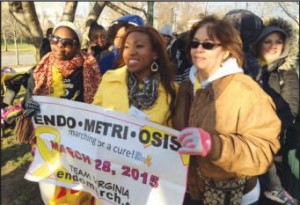
Chandelis marching with Team Virginia at the Endo march on Capitol Hill. (Photos by Jonathan Hunter)
Cassandra Nivens has experienced painful periods since age 14. To cope with being mostly incapacitated for some time each month, Nivens learned to manage what she believed were normal hormonal shifts, often scheduling time away from school and work around a 28-day cycle. It wasn’t until a routine ultrasound during her first pregnancy that her painful periods were diagnosed as endometriosis.
Defined as a condition where tissue that normally grows inside the uterus grows outside of it, endometriosis impacts 176 million women. Each month as the lining of the uterus sheds and the blood and tissue is released, the same thing happens to the tissue outside the uterus. But with no way for the released tissues to leave the body, inflammation and scar tissue develop. While endometriosis affects White women 33 percent more often, deaths from undiagnosed endometrial cancer is roughly 80 percent higher among African-American women.
“I was relieved to be able to put a name to what felt like some type of torture I endured every month, but was scared and concerned for the health of my baby. My system felt out of whack because of the pregnancy, and I was afraid that after my son was born, my hormones would go into high-gear, and it would be even more painful,” said Nivens, who found some relief in breastfeeding her healthy child.
Once her cycle resumed, Nivens she sought treatment from a naturopath. After two years of progressive yoga (from BandhaKonasana poses to hot yoga), acupuncture, and change in diet, she and her husband were able to welcome a second son.
According to research from the Mayo Clinic, Nivens is among the fortunate able to conceive with endometriosis, as an estimated 30-40 percent of infertile women have endometriosis. Because the disorder can only be definitely diagnosed through visual inspection inside of the pelvis and abdomen (as well as tissue biopsy of the implants), even ultrasounds can only hint at its presence.
General symptoms of endometriosis include: extremely painful or disabling menstrual cramps; pain increasing in severity over time; chronic pelvic pain including lower back and pelvic pain; pain during or after sex; intestinal pain; painful bowel movements; or painful urination during menstrual periods.
As more women become aware that endometriosis is more than just painful periods, the hope among physicians is that more women will note their symptoms and seek professional advice.
The Howard University Department of Obstetrics and Gynecology recently served as local sponsors of the 2015 Worldwide EndoMarch for Endometriosis to raise awareness among African Americans. The second annual march took place at Upper Senate Park in Northwest, March 28, and simultaneously in more than 56 cities worldwide.
Chandelis Duster, a Virginia precinct manager of the EndoMarch diagnosed six years ago with the condition, took part in the march to help raise awareness. “It has been a rough six years during which I have had three surgeries. Initially there was a big cyst on an ovary that needed to be drained and that was how they found endometriosis. No one had ever talked to me about it and as a freshman in college, it was scary to be told I had a disease with no cure,” Duster said.
Following a laparoscopic surgery to remove the tissue, more endometriosis was found. “It’s been tough dealing with the pain constantly and everyday… a heating pad is best friend. It has gotten better since the last surgery, but emotionally, it is a lot to deal with and it is a financial strain,” Duster said.
Among African-American women, endometriosis is one of the most common indications for major gynecological surgery and hysterectomy.


